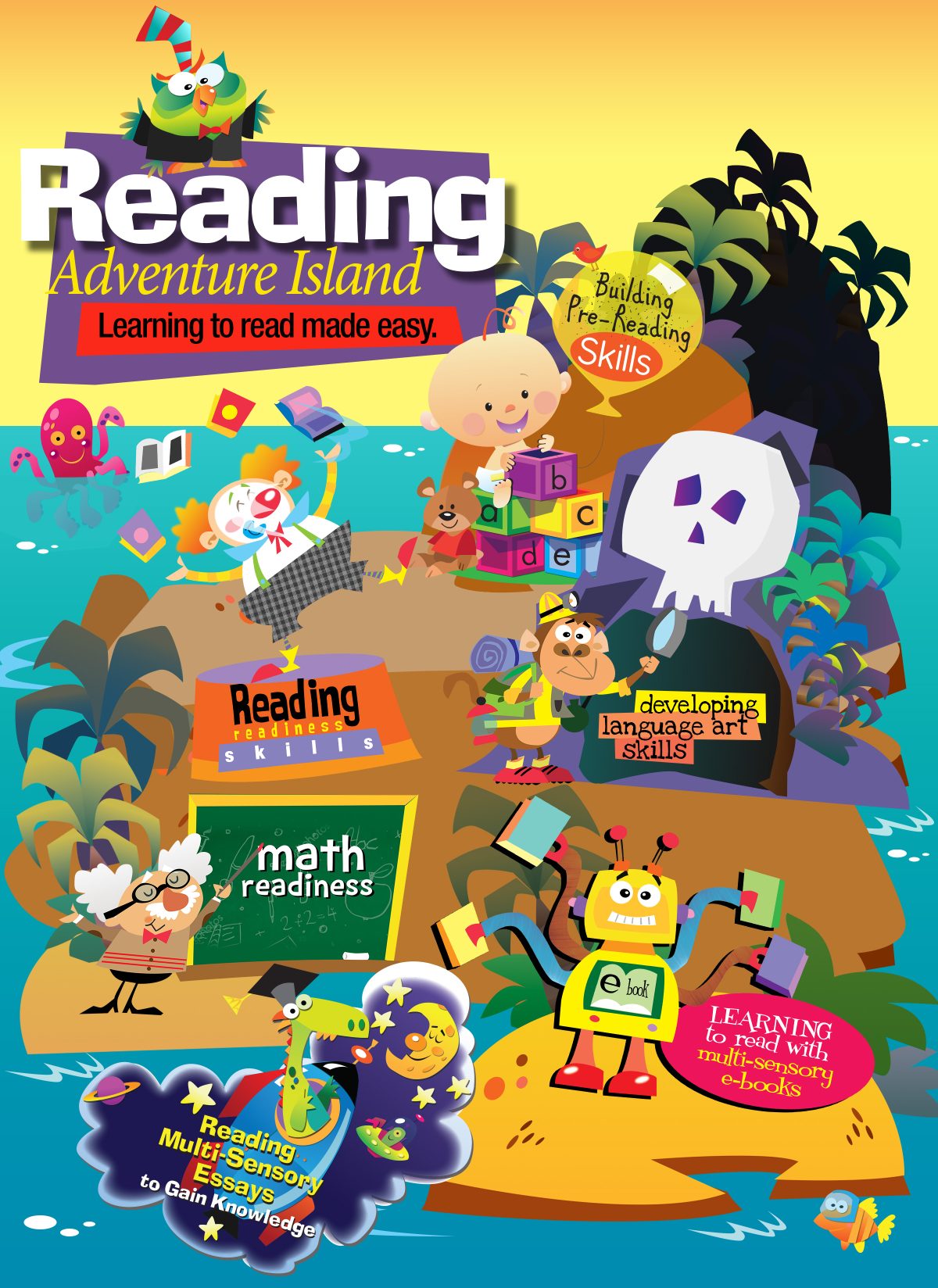Step 1: Building Pre-Reading Skills (Ages 1 – 2)
Before a child can begin to read, they need to develop pre-reading skills that lay the groundwork for learning to read. Pre-Reading Goals:
• Babies and toddlers learn simple signs to describe what they see and feel before they can talk.
• Babies and toddlers learn that objects have words connected to them.
• Babies and toddlers learn to say (pronounce) the word and object.
• Babies and toddlers learn how words and objects are used in a sentence.
Step 2: Reading Readiness Skills: Learning the Alphabet, Consonants, Consonant Blends & Vowels (Ages 3 – 6)
The alphabet is the cornerstone of reading. Mastery of the alphabet provides children with the tools to decode written language. Reading Readiness Goals:
• Pre-Schoolers learn to identify each letter of the alphabet by name and shape, both uppercase and lowercase.
• Pre-Schoolers learn the alphabet and the sounds associated with each letter in the alphabet.
• Pre-Schoolers learn about beginning and ending consonants, consonant blends and other associated sounds with each consonant.
• Pre-Schoolers learn about vowels and the sounds associated with each vowel
Pre-Schoolers learn hundreds of sight words
Step 3: Building a Vocabulary of Sight Words
Sight words are an essential component of early reading development. These are words that appear frequently in texts and are often difficult to sound out phonetically. By recognizing sight words instantly, readers can improve their fluency and comprehension.
Sight words are commonly used words that readers should learn to recognize by sight, rather than by decoding them letter by letter. Examples include words such as “the,” “and,” “is,” and “was.” These words often do not follow standard phonetic rules, making them challenging for beginning readers to decode.
Step 4: Developing Language Art Skills (Grammar): Putting Letters Together to Form Words and Using Words to Form Sentences (Ages 4 – 8)
Grammar is the proper use of a language, and it includes topics like syntax (the order of words in a sentence), punctuation, parts of speech, tenses, mechanics, and more. Besides enhancing reading comprehension, grammar skills are key in written and spoken communication, ensuring a child is able to communicate easily and is understood correctly. Language Arts Goals:
• Pre-Schoolers learn to combine individual letter sounds to form words, such as /c/ + /a/ + /t/ = “cat.”
• Pre-Schoolers learn to identify patterns in words, such as “-at” in “cat,” “bat,” and “hat.”
• Pre-Schoolers learn first vocabulary words including colors, shapes, opposites, synonyms, and sizes
• Pre-Schoolers learn new vocabulary words and the meaning of those words.
• Pre-Schoolers learn how to look up and learn the meanings of unfamiliar words.
• Pre-Schoolers learn how to use nouns and pronouns in sentences.
• Pre-Schoolers learn how to use verbs, adjectives, and adverbs in sentences.
• Pre-Schoolers learn how to form sentences with words
This step is essential for learning about the sounds that make up words and using words to form sentences.
Step 5: Math Readiness: Developing Math Skills (Ages 3 – 8)
An important part of the literacy process is to develop math skills. At the heart of mathematics lies an understanding of numbers, counting and their relationships. These skills form the building blocks for later arithmetic and problem-solving abilities. Elementary Math Goals:
• Smart Kidz learn how to identify numbers in written and spoken formats.
• Smart Kidz learn how to count and the sequence of numbers, forward and backward.
• Smart Kidz learn to understand larger and smaller quantities.
• Smart Kidz learn to match numbers to objects in a set
• Smart Kidz learn single-digit operations—progressing to multi-digit numbers.
• Smart Kidz learn times tables and multiplication as the inverse of division.
• Smart Kidz learn division as the inverse of multiplication
• Smart Kidz learn how to tell time
• Smart Kidz learn how to count money
Step 6: Learning to Read with Multi-Sensory E-Books
The process of learning to read has undergone a transformative evolution with the introduction of digital media integrated into multi-sensory e-books. In the digital age, the landscape of reading and learning has significantly evolved, offering new sense modalities that enrich the traditional experience of printed text. Multi-Sensory Digital Media modalities, in the form of visuals, sound, highlighted words, music, sound effects and other interactive sensory modes, have emerged as powerful tools for beginning readers, providing them with opportunities to develop literacy skills, enhance comprehension, and foster a lifelong love for reading.
Step 7: Using the Power of Reading to Gain Knowledge
Reading is more than a pastime—it is an investment in knowledge, personal growth, and empowerment. By engaging with a variety of texts and employing effective reading strategies, young learners can begin to unlock vast reservoirs of wisdom and insight. Whether through the pages of a novel, the lines of interesting topics, or the pixels on a digital screen, the journey of gaining knowledge through reading is a lifelong adventure worth embracing.
Reading with a Purpose
Once young readers have mastered basic reading skills (as taught on the Adventure Learning Island), they can then begin to “read with a purpose—that is, using their reading skills to gain knowledge. Defining a clear goal before reading about a topic will enhance focus. Whether it is understanding a specific concept, preparing for a discussion, or solving a problem, having a reading objective allows the reader to approach the material with intent and discernment.
Introduction to Multi-Sensory Essays
Smart Kidz Media has created and produced a new reading platform called Multi-Sensory Essays: Reading with a Purpose. These essays focus on general knowledge and other interesting topics that appeal to young readers. In other words, Multi-Sensory Essays encourage young readers to use their reading skills to “read with a purpose” or to gain knowledge about the world around them.
Multi-Sensory Essays combines its texts with the highlighting of words as the audio narration of the essay is being read. This technique not only holds the young readers’ attention, but it strengthens their reading skills while gaining valuable knowledge. Multi-Sensory Essays foster a richer and more engaging reading experience for learners of all ages.
Step 8: Parents’ Role: Creating a Learning Home Environment
Setting Up a Home Learning Environment
Parents are children’s first and most important teachers in the home. To ensure that children learn how to read, it is important that parents create a learning environment in the home. An important part of creating a learning environment is the parents’ commitment to make “literacy” a priority. Parents show their commitment to literacy by building a home library, reading books together, teaching life skills, and doing educational activities together
Continuous Support
Practice makes Perfect: Just like learning to play a musical instrument, learning to read takes commitment, practice and repetition. This is why a parent’s continuous encouragement and support are necessary. The Learning Adventure Island provides parents with reading resources that support the home learning environment with fun and entertaining games in the areas of reading, math, science, and language arts.



